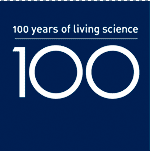Timeline
- 1845 – 1899 |
- 1900 – 1909 |
- 1910 – 1919 |
- 1920 – 1929 |
- 1930 – 1939 |
- 1940 – 1949 |
- 1950 – 1959 |
- 1960 – 1969 |
- 1970 – 1979 |
- 1980 – 1989 |
- 1990 – 1999 |
- 2000 – present
Imperial College 1960 - 1969
World
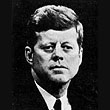 1963 - Assassination of JFK
1963 - Assassination of JFK
John F. Kennedy, the thirty-fifth President of the United States, was assinated on Friday, November 22, 1963, in Dallas, Texas, USA at 12:30 p.m. CST. Kennedy was fatally wounded by gunshots while riding with his wife in a presidential motorcade through Dealey Plaza.
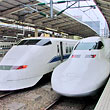 1964 - Japan's Bullet Train Opens
1964 - Japan's Bullet Train Opens
The Shinkansen - which translates literally as "new main line" - was first opened in 1964 with trains speeding from Tokyo to Osaka at speeds which slashed the 320 mile journey to just three hours.
back to top
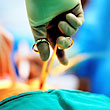 1967 - World's first Heart Transplant
1967 - World's first Heart Transplant
On December 3, 1967, South African surgeon Christiaan Barnard conducted the first heart transplant on 53-year-old Louis Washkansky in Cape Town. The surgery was a success. However, the medications that were given to Washkansky to prevent his immune system from attacking the new heart also suppressed his body's ability to fight off other illnesses. Eighteen days after the operation, Washkansky died of pneumonia.
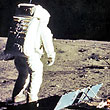 1969 - First man on the moon
1969 - First man on the moon
American Neil Armstrong has become the first man to walk on the Moon. The astronaut stepped onto the Moon's surface, in the Sea of Tranquility, at 0256 GMT, nearly 20 minutes after first opening the hatch on the Eagle landing craft. Armstrong had earlier reported the lunar module's safe landing at 2017 GMT with the words: "Houston, Tranquility Base here. The Eagle has landed." As he put his foot down on the lunar surface, Armstrong declared: "That's one small step for man, one giant leap for mankind."
College
 1960 - Clem joins the Royal School of Mines as its motorised mascot
1960 - Clem joins the Royal School of Mines as its motorised mascot
Clementine II (Clem) is the Royal School of Mines motorised mascot. She is a 1926 Morris T-type (tonner) truck and was bought by the RSMU in 1960 as a replacement for their previous mascot, Clementine I - a five ton Aveling and Porter steam traction engine.
Listen to a description of Clem from 1957
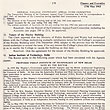 1963 - Special Relationship with the Indian Institute of Technology (Delhi)
1963 - Special Relationship with the Indian Institute of Technology (Delhi)
The special relationship with the Indian Institute of Technology (Delhi) was launched in 1963. It was to include long term secondments of Imperial staff, the training of Indian staff and short visits to Delhi by senior Imperial staff. Professor Sir Willis Jackson headed the Imperial initiative and chaired the group involved. Professor N. P. W. Moore of Mechanical Engineering was the first seconded member of Imperial staff to visit Delhi.
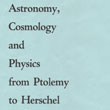 1963 - Department of History of Science and technology opened
1963 - Department of History of Science and technology opened
The teaching of the history of science and technology at Imperial began in 1963, with the first Professor A. Rupert Hall. The department was based in Queen's Gate and taught postgraduate students.
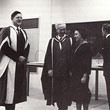 1963 - Princes Margaret opens Southside, Electrical Engineering and Civil Engineering buildings
1963 - Princes Margaret opens Southside, Electrical Engineering and Civil Engineering buildings
HRH Princess Margaret opened Southside Halls of Residence on 8th October. This increased student accommodation so that 20% could live in halls, compared to 8% in 1955.
Listen to Sir Patrick Linstead’s speech from the official opening ceremony of Southside in 1963.
After she had opened Southside, she visited two other new buildings at South Kensington. In Electrical Engineering, she was given a demonstration of bandwidth compression and in Civil Engineering she viewed a model dam.
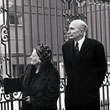 1963 - Falmouth Gates given as memorial to Lord Falmouth
1963 - Falmouth Gates given as memorial to Lord Falmouth
The Falmouth Gates were designed as a memorial to Viscount Falmouth, Chairman of the Governing Body 1947-1962 and placed at the East entrance to Imperial by 170 Queen's Gate. They were inaugurated by Lady Falmouth.
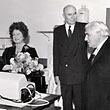 1965 - Biochemistry Building opened
1965 - Biochemistry Building opened
On Thursday 4th November 1965, Her Majesty Queen Elizabeth the Queen Mother, Chancellor of London University opened the new Biochemistry Building. She unveiled a commemorative plaque and was presented with a bouquet by Judith and Daniel Chain, the 8 year old twins of Professor Ernst and Mrs Anne Chain, Professor Chain being head of the Biochemistry Department. Listen to the opening ceremony.
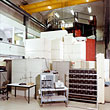 1965 - Nuclear Reactor opened
1965 - Nuclear Reactor opened
An increasing demand for research and training facilities in nuclear science led in 1961 to a Government announcement of a national programme for the provision of low-power nuclear reactors to be available to universities and colleges of technology. Three reactors were approved in principle, one to serve the needs of the South of England. The University of London subsequently decided that this reactor should be located at the Imperial College Field Station at Silwood Park where the College would be responsible on behalf of the University for its management.
The project was financed for an initial period of five years from 1962 by a grant from the Science Research Council and subsequently supported by the University with funds from the University Grants Committee. The 100 kW 'Consort' Reactor Mark II, which was designed jointly by the Nuclear Power Group of the Mechanical Engineering Department at Imperial College and by the General Electric Company Limited, commenced operation in April 1965. A new building adjoining the reactor hall was completed in 1971 and provides radiochemistry and physics laboratories, workshops and office and study accommodation.
back to top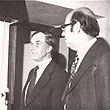 1966 - Physiological Flow Studies Unit opened
1966 - Physiological Flow Studies Unit opened
Founding staff of the Physiological Flow Studies Unit included Professor Colin Caro and Bob Schroter. The creation of the unit was instigated by joint research between Colin Caro a physician and James Lighthill, an applied mathematician and fluid dynamist. They applied medical and engineering knowledge to study of blood and body fluid circulation and respiration.
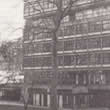 1968 - Opening of Linstead Hall
1968 - Opening of Linstead Hall
Construction was funded by an anonymous benefactor in 1963 who stipulated that dining facilities must be available for male residents. Originally known as New Hall, it was named Linstead Hall after Sir Patrick Linstead, who died prematurely in 1966. Sir Patrick was the Rector responsible for obtaining the land on Princes’s Gardens for student accommodation. It was his vision that every student should have the opportunity of spending a year in a hall of residence.
 1969 - College appeal launched to raise 2 million for costs towards student accommodation
1969 - College appeal launched to raise 2 million for costs towards student accommodation
An appeal for £2million for student and staff accommodation and for academic and general purposes was launched in 1969:
- £1.1 million for residential building and conversion
- £200,000 for the development of Silwood park, for laboratory blocks and student accommodation
- £700,000 for academic and general purposes as Imperial almost completely lacked endowment.
Speakers at the appeal launch were Lord Sherfield, Chairman of the Governing Body; Lord Penney, Rector; Professor M.J.Lighthill, Royal Society Research Fellow at Imperial and Rex Lowin, the President of the Imperial College Students Union.
back to top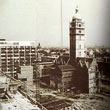 1969 - Demolition of the Imperial Institute and completion of Queen's Tower as free standing campanile
1969 - Demolition of the Imperial Institute and completion of Queen's Tower as free standing campanile
Following the move of the Imperial Institute to the Commonwealth Institute, it became clear that the Institute building was no longer suitable for its original purpose of being a "scientific research institution exploring and developing the raw materials of the Empire countries". It was not adaptable to the College requirements for mid 20th century science and technology. It was agreed that the building should be demolished to enable the expansion of Imperial College and the building of modern laboratories, under the auspices of the governments plan for development of science and technology in higher education.
Plans for this were well developed when a campaign against the demolition developed, led by the Poet Laureate and great supporter of Victoriana, John Betjeman. Press articles appeared and as the pressure mounted, parties on both sides had their say. As Lord Home stated - "many will regret this change in the Kensington landscape. But it is symbolic of the needs of the times that we can no longer rest on the memorials of past greatness but must prepare for a new but different greatness of the future." Julian Huxley suggested in a letter to the Times that the situation be resolved by retaining the Collcutt Tower (now the Queen's Tower) as a free standing campanile. This compromise was accepted, though it took another ten years for this work to be completed, with the planning being undertaken by the Civil Engineering Department.
During demolition, a casket was found under the foundation stone, the Bhownagree casket. This contained a lock of hair of Awabia Merwanje Bhownagree, the sister of Sir Mancherjee Merwanjee Bhownagree. Mr Bhownagree funded the colonnade which connected the Jehangir Hall with the Indian Gallery.
back to top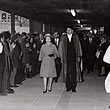 1969 - Opening of the College Block (Sherfield Building) and Library
1969 - Opening of the College Block (Sherfield Building) and Library
The College Block, including the Administration and Library Buildings, was initially known was opened by her Majesty the Queen, in November 1969.
-
Listen to a recording of the official opening
-
Watch a film clip of the opening ceremony
People
 Colin Cherry (1914-1979)
Colin Cherry (1914-1979)
Colin Cherry joined Imperial in 1947. He became Henry Mark Pease Professor of Telecommunication in 1958. Cherry fostered research in the technical and theoretical aspects of telecommunication, including digital signal processing, coding theory and global communication. His book On Human Communication (1957) was very influential, especially among the young.
He was one of the first to promote the use of TV in the classroom and one of his ideas that was promoted by the press was world government by television. He was also an early promoter of televising parliament. He focused on auditory attention, specifically regarding the cocktail party problem. This concerns the problem of following only one conversation while many other conversations are going on around us. He conducted many experiments trying to explain this. His contributions influenced cognitive science (he is often considered to be a pioneer in this field even though he would never describe himself as a cognitive scientist).
back to top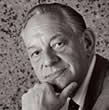 Professor Eric Laithwaite (1921-1997)
Professor Eric Laithwaite (1921-1997)
Eric Laithwaite was Professor of Heavy Electrical Engineering at Imperial between 1964 and 1986, Emeritus since 1986 and Fellow of Imperial College since 1990.
Between 1941 and 1946 Laithwaite served in the RAF and spent two years at RAE Farnborough working on automatic pilots. He graduated from Manchester University in 1949, undertook postgraduate research in electronic computer design and became Assistant Lecturer in 1950, Lecturer 1953 and senior lecture 1958, gaining his PhD in 1956. Laithwaite was an active member of the Institution of Electrical Engineers and a member of the British Transport Commission’s Special Advisory Panel on Electric Traction.
Laithwaite rediscovered in 1947 (at that time at the University of Manchester) the linear motor. A linear motor is an electric motor that has had its stator "unrolled" so that instead of producing a rotation, it produces a linear force along its length. He devoted a big part of his scientific life in the development of this technology.
He was a pioneer in the development of magnetic-levitated high-speed trains. Maglev (magnetic levitated) trains were built in Germany and Japan and more recently in other countries. The use of linear motors is growing in motion control applications. They have also been suggested for use in spacecraft propulsion - Laithwaite was working on a similar project for NASA when he died.
Watch an interview with Professor Laithwaite from 1980.
See footage of Professor Laithwaite in his labs: http://ichelix1.cc.ic.ac.uk/ramgen/mediaspool/centenary/laithwaite_demo.rm
http://ichelix1.cc.ic.ac.uk/ramgen/mediaspool/centenary/laithwaite_demo2.rm
http://ichelix1.cc.ic.ac.uk/ramgen/mediaspool/centenary/laithwaite_rtv31.rm
 Professor Klaus Friedrich Roth FRS (1925 - )
Professor Klaus Friedrich Roth FRS (1925 - )
Educated at Cambridge, Roth moved to University College London to undertake research and take up the appointment of assistant lecturer, becoming a professor in 1961.
He took up the Chair at Imperial College in 1966. Roth retained the Chair until 1988 when he became a visiting professor until 1996. Roth was awarded the Fields Medal in 1955 for work on the number theory, the Thue-Siegal-Roth Theorem related to algebraic numbers. His later work was on Szemeredi's theorem and Selburgh's Sieves.
back to top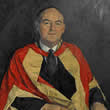 Sir Owen Alfred Saunders (1903-1993)
Sir Owen Alfred Saunders (1903-1993)
Owen Saunders was educated at Birkbeck College and Trinity College Cambridge, obtaining degrees in both Mathematics and Sciences. He worked at the Fuel Research Station East Greenwich, between 1926 and 1932, where he met two lifelong colleagues, Margaret Fishenden and Cecil Lander who also became staff members at Imperial, Saunders joined Imperial as Lecturer in the Mechanical Engineering Department in 1932. He was appointed the first Clothworkers Reader in Applied Physics in 1937. His interest in aircraft piston engines and then jet engines led to his being seconded to the Ministry of Aircraft Production in 1942 where he was responsible for turbine engine research and worked with Sir Frank Whittle and Sir Harold Roxbee Cox. He returned to Imperial as Professor and Head of the Mechanical Engineering Department in 1946, succeeding Lander. Besides researching engines, Saunders worked with Margaret Fishenden on heat transmission, they jointly produced a book on it in 1932, which was the standard text for many years.
Saunders was the Dean of the City and Guilds College and Pro-Rector between 1964-1966.
On the sudden death of Sir Patrick Linstead in 1966, he was acting Rector until, in 1967, he became Vice Chancellor of the University of London.
back to top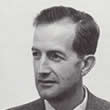 Professor Alan Wilfred Bishop (1920-1988)
Professor Alan Wilfred Bishop (1920-1988)
Alan Bishop first joined Imperial in 1946 to work with Southwell on stress analysis of embankment dams. He also worked with Alec Skempton. He became Professor of Soil Mechanics in 1965 and was Dean 1970-1973. He was very inventive in designing equipment and a great experimentalist. His designs were taken up by soil mechanics labs around the world.
His work included the design of dams and he was a member of the Institution of Civil Engineers Committee on Reservoir Safety. He retired from Imperial in 1980. Bishop acted as consultant on many large projects and chaired the team of investigators at the 1966 Aberfan colliery tip slide disaster. The outcome of the inquiry in which Bishop led the team of technical advisors , and was involved in advising on the legislation that followed, having a great impact on safety and security in the mining industry.
back to top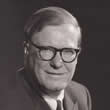 William Penney, Baron Penney of East Hendred
William Penney, Baron Penney of East Hendred
William Penney worked as a Laboratory Assistant before gaining a scholarship to study at Imperial, where he obtained his BSc and PhD, in mathematics. He then went to the University of Wisconsin and gained an MA, then to Trinity College Cambridge on an 1851 Senior Student Scholarship and a PhD on the application of quantum mechanics to the physics of crystals.
Between 1936 and 1945 he was Assistant Professor Mathematics at Imperial. He also undertook work for the Admiralty, which included studying underwater blast waves and assisted with the design of the Mulberry Harbours, the protective floating harbours that allowed disembarkment for the Allied invasion of France to take place on D-Day.
At the Home Office his appointments led to his becoming Principal DSIR Scientific Officer. In this capacity he was part of the British team working on the atomic bomb, code named the Tube Alloys Project, released from Imperial, he was then seconded to work on the Manhattan Project at Los Alamos, when the Allies combined their atomic bomb development in 1944.
He remained there until 1945, working on calculations relating to the release of the bomb. He witnessed the Nagasaki explosion at a distance as the observation plane he was allowed at short notice to board was delayed. He was part of the investigative team which visited Nagasaki and Hiroshima to assess the aftermath of the bombs in 1945.
Penney next became director of work on the British atomic bomb until its first test in 1952. declining a Chair at Oxford, he continued to work in the nuclear industry and was a Board member of the newly formed UKAEA, United Kingdom Atomic Energy Authority, then Chairman between 1964 and 1967.
He became Rector of Imperial in 1967. In recognition of his services to Britain he was appointed OBE in1946, OBE Knight Commander 1952 and a life peerage as Lord Penney of East Hendred in 1967.and OM 1969. He was Rector of Imperial between 1967 and 1973, at what he felt was a difficult time for College administration, although he was an able and successful leader of Imperial. He did not leave any personal papers, deciding to burn his collection shortly before he died. The William Penney Laboratories, a new building for Computing, opened on the South Kensington Campus in 1988.
back to top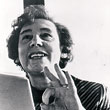 Professor Joan Woodward (1916-1971)
Professor Joan Woodward (1916-1971)
Joan Woodward was the second woman professor at Imperial. She joined the College in 1957 as a part time lecturer in Industrial Sociology and was appointed to a Senior Lectureship in the Production Engineering Section in 1962. She was invited to work part time for the Ministry of Labour in 1964. Woodward was appointed Professor of Industrial Sociology and Director of the Industrial Sociology Unit in 1969. She published a book in 1970 entitled Industrial Organisation: Behaviour and Control describing the research work undertaken by her group since 1962.
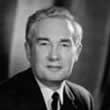 Sir Derek Barton
Sir Derek Barton
Sir Derek Barton, Professor of Organic Chemistry at Imperial College was a leading chemist. His seminal work on the conformation of organic molecules led to his being awarded the Nobel Prize for Chemistry in 1969 (jointly with Odd Hassel).
Derek Barton studied Chemistry at Imperial College (BSc 1940, PhD 1942), working under Ian Heilbron. He became Assistant Lecturer at Imperial in 1945. Between 1946 and 1949 he was Imperial Chemical Industries Research Fellow. After a year at Harvard (where he wrote the Nobel-prize winning paper on conformational analysis) he came back to Britain.
In 1957 he became Professor of Organic Chemistry at Imperial, a position he retained until 1972. During his Imperial years he was awarded the Nobel Prize and a knighthood. His work on conformational analysis, especially his research on the spatial arrangements of organic molecules and reactions mechanisms, play an important role in organic chemistry. Conformational analysis altered the way in which chemists think about the shape and reactivity of molecules in three-dimensional space.
back to top© 2007 Imperial College London
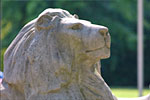
Through the first decade of the twenty-first century the campaign seeks to philanthropically raise £207 million from Imperial’s alumni, staff and friends, and donations from charitable foundations and industry.
Where your support can make a differenceGive now

We’re celebrating 100 years of living science with 100 stories. We’ve collected some of them already, and invite you to share your own stories and memories.

